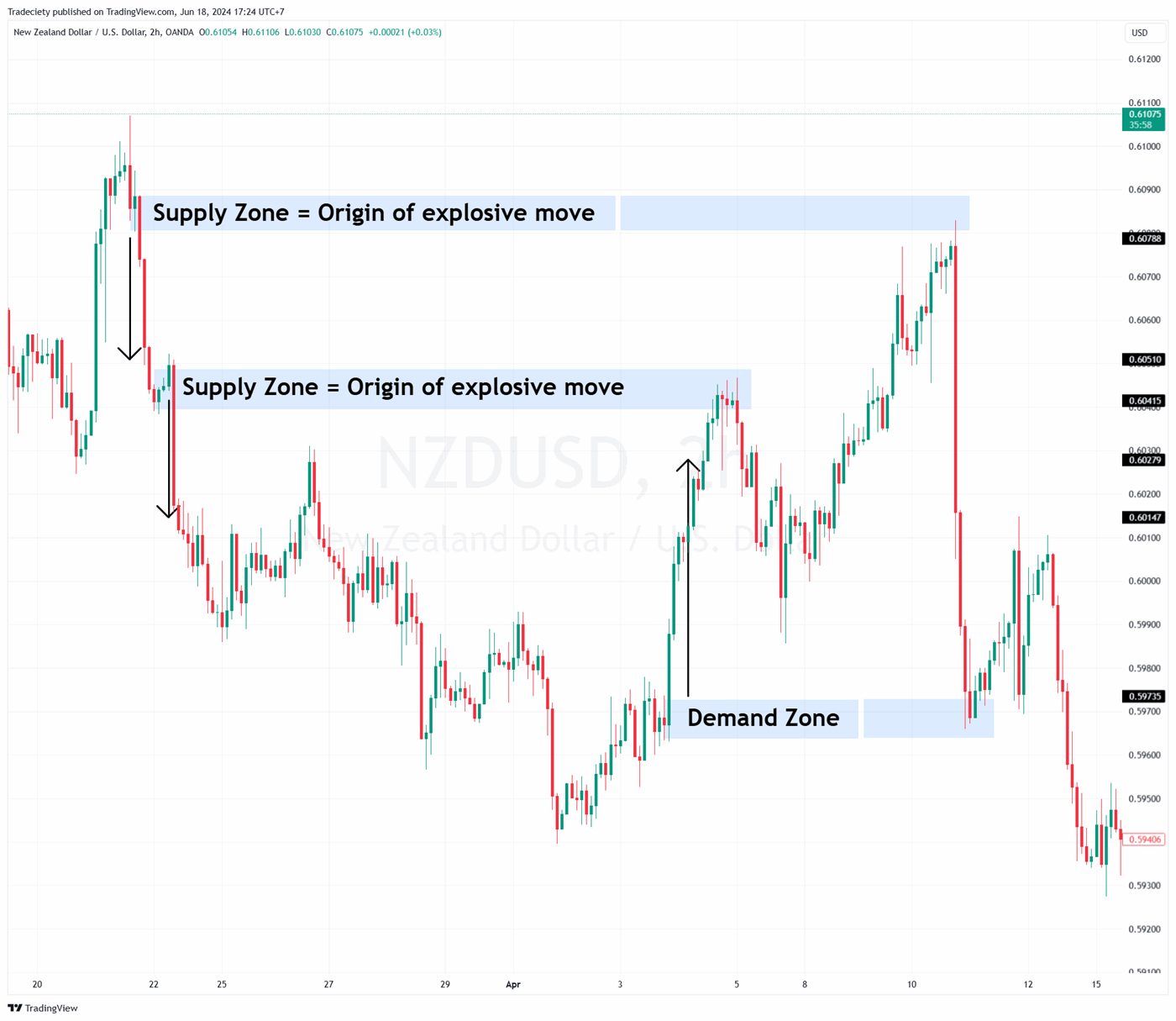Identify how to use supply and demand zones when trading options on a chart to spot potential reversal points. Use these zones to plan entry and exit strategies.
How to use supply and demand zones when trading options are crucial concepts in trading options. These zones represent areas where the price is likely to reverse. Understanding these zones helps traders make informed decisions. Supply zones indicate where selling pressure exceeds buying interest. Conversely, demand zones show where buying interest outweighs selling pressure.
Traders use these zones to identify potential entry and exit points. This strategy enhances the probability of successful trades. By analyzing historical price movements, traders can spot these zones. Properly using supply and demand zones can significantly improve trading outcomes. This method aligns with technical analysis principles. Traders need to practice identifying these zones to achieve consistent results.
Table of Contents

How To Trade Demand And Supply Zones?
Trading options using supply and demand zones involves identifying key price levels where buying or selling pressure is strong. Analyze historical price movements to spot these zones, then use them to guide entry and exit points. This strategy helps optimize trades by aligning with market momentum.
Trading demand and supply zones can be a powerful strategy for options traders. These zones represent areas on a chart where buying or selling pressure has previously been strong, often leading to significant price movements. Understanding how to identify and trade these zones can improve your trading performance.
Identifying Demand And Supply Zones
Finding these zones on a chart is the first step. They are marked by areas where price movements show strong buying or selling activity.
- Demand Zones: These are areas where the price has previously rallied. They indicate strong buying interest.
- Supply Zones: These are areas where the price has previously dropped. They indicate strong selling interest.
Drawing Demand And Supply Zones
Once identified, these zones need to be marked on your trading chart. This helps in recognizing potential trade opportunities.
- Highlight the Zone: Draw a rectangle around the area where multiple price rejections occurred.
- Extend the Zone: Extend the rectangle forward in time to see if the price respects these areas in the future.
Trading Strategies For Demand Zones
Trading in demand zones involves looking for buying opportunities. These zones suggest a price increase when revisited.
- Buy at Support: Enter a buy trade when the price hits the demand zone.
- Confirm with Indicators: Use additional indicators like RSI or MACD to confirm the buy signal.
- Set Stop-Loss: Place a stop-loss just below the demand zone to minimize risk.
Trading Strategies For Supply Zones
Supply zones signal potential selling opportunities. These areas could lead to a price decline when revisited.
- Sell at Resistance: Enter a sell trade when the price hits the supply zone.
- Use Volume Indicators: Confirm the sell signal with volume indicators to gauge market sentiment.
- Place Stop-Loss: Set a stop-loss just above the supply zone to protect your trade.
Managing Risk In Demand And Supply Zone Trading
Risk management is crucial. Properly managing your risk can protect your trading capital.
- Position Sizing: Determine the size of your trade based on your risk tolerance.
- Diversify Trades: Spread your trades across different assets to reduce risk.
- Monitor Trades: Regularly check your trades and adjust stop-loss levels as needed.
Enhancing Your Trading Plan
Incorporate demand and supply zones into a broader trading strategy. This ensures a well-rounded approach.
- Combine with Trend Analysis: Use trend lines to confirm the strength of demand and supply zones.
- Backtest Your Strategy: Test your strategy on historical data to assess its effectiveness.
- Stay Updated: Keep learning and stay updated with market news and trends.
Understanding and trading demand and supply zones can give you an edge in the options market. By following these strategies, you can make more informed trading decisions and potentially increase your profitability.
How To Identify Strong Supply And Demand Zones
Spotting strong supply and demand zones involves analyzing historical price movements and identifying areas with significant price reversals. Traders can use these zones to predict potential price changes and make informed options trading decisions. Recognizing these key levels helps optimize entry and exit points.
Trading options can be highly rewarding, especially when you know how to use supply and demand zones. These zones help identify potential price reversal points. To effectively trade, you must first identify strong supply and demand zones.
Understanding Supply Zones
Supply zones indicate where sellers outnumber buyers, causing prices to fall. Identifying these zones involves observing certain patterns:
- Resistance levels: Look for price points where the asset repeatedly fails to break through.
- High volume areas: Notice where there is a significant increase in trading volume, signaling strong seller presence.
- Price action: Watch for sharp declines following a peak; these often mark strong supply zones.
Recognizing Demand Zones
Demand zones are areas where buyers outnumber sellers, leading to price increases. To spot these zones:
- Support levels: Identify points where prices consistently bounce back up.
- Volume spikes: Monitor areas with increased buying activity, indicating strong demand.
- Price action: Look for significant price jumps from a low point, often indicating a robust demand zone.
Using Historical Data
Examining historical data provides insights into supply and demand zones. Here’s how to utilize this data effectively:
- Historical peaks and troughs: Check past high and low points to identify potential zones.
- Repeated patterns: Look for recurring price behaviors at certain levels.
- Long-term trends: Analyze extended periods to spot persistent supply and demand areas.
Tools And Indicators
Utilizing tools and indicators can enhance your zone identification process. Here are some helpful tools:
- Moving averages: These help identify long-term price trends and potential zones.
- Relative Strength Index (RSI): This indicates overbought or oversold conditions, which may align with supply and demand zones.
- Volume Profile: This tool shows the volume traded at various price levels, helping identify key zones.
Practical Application
Putting theory into practice is crucial for effective trading. Here are steps to apply your knowledge:
- Chart analysis: Regularly analyze charts to spot supply and demand zones.
- Set alerts: Use trading platforms to set alerts for key price levels.
- Practice: Continuously practice identifying zones to refine your skills.
Common Mistakes To Avoid
Avoiding common pitfalls can save you from costly mistakes. Here are some mistakes to watch out for:
- Ignoring volume: Always consider trading volume when identifying zones.
- Overcomplicating analysis: Keep your analysis straightforward and focused.
- Failing to adapt: Be ready to adjust your zones as market conditions change.
What Is The Best Timeframe For Supply And Demand Zones?
Daily and weekly charts are ideal for identifying supply and demand zones in options trading. These timeframes provide clearer market trends and more reliable signals.
Understanding the best timeframe for supply and demand zones can significantly enhance your trading strategy. It’s essential to know how to choose the right timeframe to make informed decisions.
Daily Timeframe
Using the daily timeframe offers several benefits:
- Comprehensive View: Provides a broad perspective on market trends.
- Reliability: Daily zones are more dependable and less prone to false signals.
- Stress-Free: Reduces the need for constant monitoring.
Intraday Timeframe
For those who prefer a more active approach, the intraday timeframe is suitable. Consider the following points:
- Higher Frequency: Identifies multiple trading opportunities within a day.
- Quick Decisions: Requires rapid analysis and execution.
- Smaller Moves: Captures smaller price fluctuations for quick profits.
Weekly Timeframe
The weekly timeframe offers a long-term perspective. Here’s what makes it unique:
- Long-Term Trends: Helps identify major market trends.
- Patience Required: Not ideal for those seeking quick trades.
- Higher Accuracy: Generally more accurate due to fewer market noises.
Combining Timeframes
Combining multiple timeframes can provide a more nuanced view. Here’s why this method works:
- Multi-Dimensional: Offers both short-term and long-term perspectives.
- Confirmation: Confirms trends seen in smaller timeframes with larger ones.
- Flexibility: Adapts to different market conditions.
Choosing the best timeframe depends on your trading style and goals. Each timeframe offers unique advantages, and understanding them can lead to more effective trading strategies.
Supply And Demand Trading Rules
Master supply and demand zones to enhance your options trading strategy. Identify key price levels where supply and demand shift. Optimize trade entries and exits by understanding these critical zones.
Trading options can be a game-changer when you understand supply and demand zones. These zones highlight areas where price moves significantly, which can be pivotal in your trading decisions. Knowing the rules behind these zones can guide you to more strategic trades.
Identifying Supply Zones
Supply zones indicate areas where sellers are likely to outnumber buyers. Recognizing these zones can help in predicting price drops.
- Historical Peaks: Look for previous high points where price reversed.
- Volume Spikes: High volume at a peak often indicates strong selling pressure.
- Price Consolidation: Areas where price moves sideways before dropping.
Identifying Demand Zones
Demand zones are areas where buyers are likely to outnumber sellers. These zones often lead to price increases.
These zones are crucial for traders to spot. They help identify potential buying opportunities:
- Historical Lows: Previous low points where price reversed.
- Volume Spikes: High volume at a low indicates buying interest.
- Price Consolidation: Areas where price moves sideways before rising.
Entry And Exit Points
Knowing when to enter and exit trades is crucial. Supply and demand zones can guide these decisions effectively.
- Entry Points: Enter near demand zones for potential price increases.
- Exit Points: Exit near supply zones to avoid potential price drops.
- Stop-Loss Orders: Place stop-loss orders just below demand zones to limit risk.
Risk Management Strategies
Effective risk management is essential for successful trading. Here’s how to manage risks using supply and demand zones:
- Position Sizing: Adjust position sizes based on distance to supply or demand zones.
- Diversification: Spread trades across multiple assets to reduce risk.
- Risk-Reward Ratio: Aim for a favorable risk-reward ratio, ideally 1:3 or better.
Monitoring Market Conditions
Market conditions can change rapidly. Keeping an eye on them can enhance your trading strategies.
Stay updated with the following aspects to adapt your strategies:
- Economic Indicators: Economic data can influence supply and demand.
- News Events: Major news can shift market dynamics quickly.
- Technical Indicators: Use indicators to confirm supply and demand zones.
Understanding these rules can significantly improve your trading outcomes. By following these guidelines, you can make more informed decisions and potentially increase your profitability.

Frequently Asked Questions
What Are Supply And Demand Zones?
Supply and demand zones are price areas where buying or selling pressure is strong, affecting market direction.
How To Identify Supply Zones?
Identify supply zones by spotting areas with significant price drops after a consolidation period. Look for high volume.
Why Are Demand Zones Important?
Demand zones indicate areas where buying interest is high. These zones often lead to price increases, offering trading opportunities.
Can Supply And Demand Zones Predict Trends?
Yes, supply and demand zones can help predict potential price reversals and trends, aiding in strategic trading decisions.
How To Draw Supply And Demand Zones?
Draw supply zones around recent price peaks and demand zones around recent price troughs. Use historical price data.
Conclusion
Mastering supply and demand zones can significantly enhance your options trading strategy. These zones help identify potential market reversals. By understanding these key areas, traders can make more informed decisions. Practice and patience will improve your skills. Start applying these concepts to see better trading results.
Happy trading!













Leave a Reply